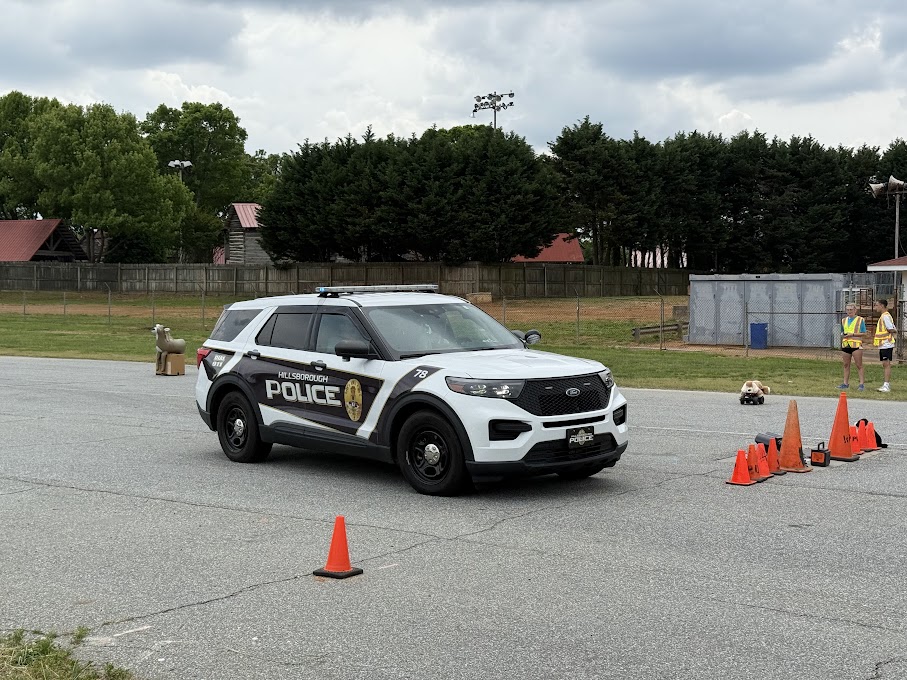“Slower is Faster” – Leadership Lessons from the Driver’s Seat

This post is written by current student Tyler Holden.
Tyler Holden is a current student in the online format. Originally from Winston-Salem, North Carolina, Holden completed his undergraduate degree in Political Science from UNC Greensboro. As a former Americorps Lead for North Carolina Fellow, he is pursuing his interests in local government and is currently employed with the Town of Hillsborough and completing his Professional Work Experience with the Hillsborough Police Department.
————————————————————————————————————–
Every year, the North Carolina League of Municipalities hosts a dynamic driver training program designed to sharpen the decision-making and driving skills of police officers across the state. Known as the “Slower is Faster” Driver Training, this hands-on experience, led by instructors skilled in the art of autocross, emphasizes precision, awareness, and thoughtful response under pressure — vital qualities for any first responder.
During the first week of my internship with the Hillsborough Police Department, I had the extraordinary opportunity to participate in this training event, held at the Winston-Salem Fairgrounds. As someone aspiring to a career in public service, this experience proved to be far more than a driving exercise — it offered deep, transferable lessons in leadership, strategy, and decision-making in government.
As part of the event, my group organized a portion of the driving course. Using road signs, inflatable deer, traffic cones, and even a remote-controlled car topped with a stuffed dog (meant to simulate a pet darting into traffic), we created a series of unpredictable obstacles. We regularly changed their positions to simulate real-world driving scenarios that officers might encounter on duty.
The objective wasn’t speed, but rather disciplined decision-making. It was about teaching officers how to remain composed, think critically, and respond appropriately in high-pressure situations.
As I observed dozens of officers navigating the course, I began noticing distinct trends. Those who accelerated too quickly on the straightaways often misjudged tight turns, leading to close calls or collisions with cones. In contrast, officers who paced themselves, slowing down strategically to assess and adapt to the layout ahead completed the course more efficiently and with greater accuracy. Just as the name of the training entails, slower really was faster. A classic case of the tortoise and the hare.
The takeaway? Rushing ahead without gauging what lies down the road often leads to errors or setbacks. But those who take the time to evaluate the landscape, anticipate obstacles, and adjust their approach accordingly tend to reach their goals more effectively.
It’s a lesson that extends far beyond the driver’s seat.
The principles behind “Slower is Faster” apply directly to leadership in local government. Just like navigating a challenging driving course, managing a municipality requires anticipating long-term needs, understanding the terrain ahead, and making deliberate, informed decisions.
Whether you’re crafting policy, managing public budgets, or planning community development, effective leadership is not always about rapid responses. It’s about thoughtful planning, steady execution, and knowing when to pause, reassess, and adapt — especially when the stakes are high.
Perhaps the most exciting moment of the training came when I had the chance to ride along with a Hillsborough Police Department officer through the full course. As we weaved through a simulated pursuit scenario complete with autocross instructors playing suspects in other vehicles, I experienced firsthand the mental and physical demands officers face when responding to emergencies.
The adrenaline, the focus, the constant decision-making — it all underscored the importance of preparation and training. It also reinforced the broader lesson: calm, measured responses are often the most effective, even in fast-paced or high-stakes environments.
Participating in the “Slower is Faster” Driver Training is a key highlight of my internship experience. It offered me not only a behind-the-scenes look at how law enforcement officers hone their skills, but also an enduring perspective on leadership, both in public safety and in public service.
As I look forward to a career in local government, I’ll carry with me the lesson that taking the time to observe, think, and plan is the best way to lead with purpose, precision, and impact.
